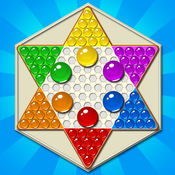
[New Rules] In response to players' calls to put an end to random walking, the following rules will be implemented from June 9, 2015: 1) Players can only take a maximum of 51 steps in the game; 2) Players who occupy other people's positions at the end of the game will be fined 8 extra points. Please take note, spread the word, and have fun! [Major update, must download! ] You definitely don’t want to miss the following new features: * Added online game lobby, you can jump online with everyone; * Added placement tips, moving footprints, etc.; * Added air jump option; * Optimized the existing 5 moving robot algorithms; unique, all the above are provided for free! The smartest Chinese checkers game on the App Store, with over 1 million downloads worldwide! The iPhone version is also online and can be downloaded for free! It has 5 different AI strategies and supports 1 to 6 players competing on the same stage! Chinese checkers, referred to as checkers (called boziqi in Hong Kong), is a kind of chess that can be played by two to six people at the same time. The board is a six-star shape, and the chess pieces are divided into six colors. Each color has 10 or 15 chess pieces. Each player occupies a corner and has one color of chess pieces. Sometimes when the number of people is small, you can also play with two colors of chess pieces per person. The predecessor of Chinese checkers is square checkers, which appeared around the Victorian era. The original board was square with a total of 256 squares. At the beginning, the chess pieces were distributed in the four corners, with the goal of jumping to the opposite corner as quickly as possible. The rules are similar to the current Chinese checkers. Soon someone changed it to a star-shaped chessboard, called Stern-Halma. It became popular in the United States in the 1930s and changed its name to Chinese Checkers. When this kind of chess piece was introduced to China, it was also called bozi chess because glass marbles were used as chess pieces (glass marbles are called "bozi" in Cantonese). In fact, Chinese checkers did not originate in China. To play, first place all the chess pieces of one color on one corner, and everyone takes turns moving the pieces in a clockwise or counterclockwise direction. One piece is moved at a time. The winner is the one who reaches the opposite corner first with all the pieces moving. There are two ways for chess pieces to move: 1) A chess piece moves to one of the six adjacent squares. 2) "Building a bridge": There is another chess piece (B) on the same straight line as your chess piece (A). It is not limited to which side it belongs to. There is no chess piece blocking the way between you. If there is no chess block on the other side of B, A can jump to the opposite direction of B, and the original distance between the two chess pieces will be the same. Jumping can be performed continuously until there are no more jumps left. If a loop occurs, choose one of the places to stop.




 360 Guardian
360 Guardian
 360 software manager
360 software manager
 driver wizard
driver wizard
 Baidu Skydisk
Baidu Skydisk
 360 browser
360 browser
 WPS Office
WPS Office
 QQ Game Hall
QQ Game Hall
 Lightning simulator
Lightning simulator
Useful
Useful
Useful